window FIAT 500 2020 Owner handbook (in English)
[x] Cancel search | Manufacturer: FIAT, Model Year: 2020, Model line: 500, Model: FIAT 500 2020Pages: 228, PDF Size: 6.01 MB
Page 146 of 228
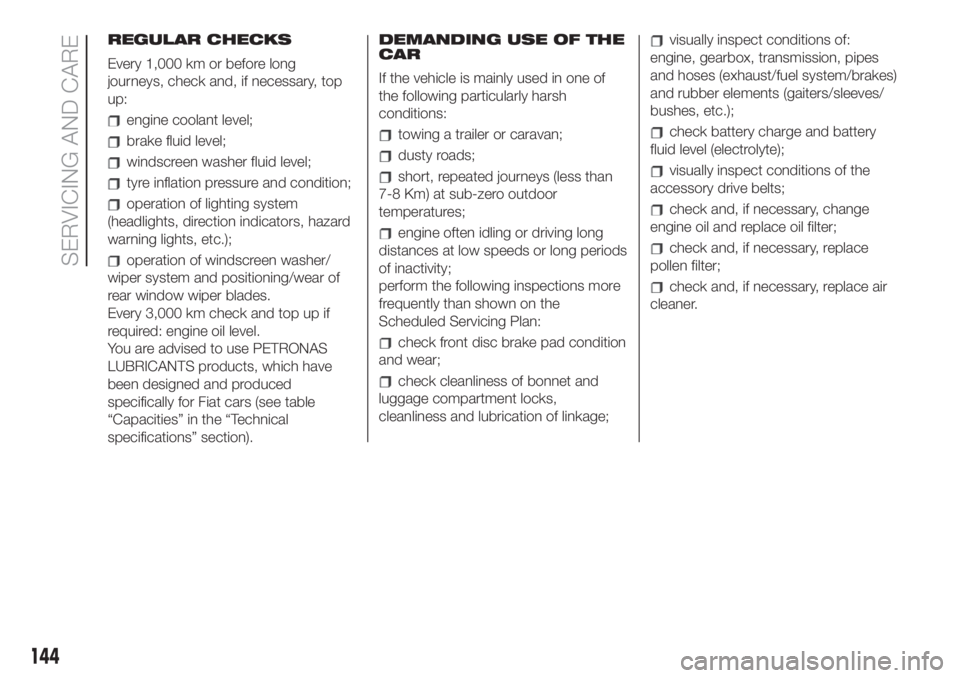
REGULAR CHECKS
Every 1,000 km or before long
journeys, check and, if necessary, top
up:
engine coolant level;
brake fluid level;
windscreen washer fluid level;
tyre inflation pressure and condition;
operation of lighting system
(headlights, direction indicators, hazard
warning lights, etc.);
operation of windscreen washer/
wiper system and positioning/wear of
rear window wiper blades.
Every 3,000 km check and top up if
required: engine oil level.
You are advised to use PETRONAS
LUBRICANTS products, which have
been designed and produced
specifically for Fiat cars (see table
“Capacities” in the “Technical
specifications” section).DEMANDING USE OF THE
CAR
If the vehicle is mainly used in one of
the following particularly harsh
conditions:
towing a trailer or caravan;
dusty roads;
short, repeated journeys (less than
7-8 Km) at sub-zero outdoor
temperatures;
engine often idling or driving long
distances at low speeds or long periods
of inactivity;
perform the following inspections more
frequently than shown on the
Scheduled Servicing Plan:
check front disc brake pad condition
and wear;
check cleanliness of bonnet and
luggage compartment locks,
cleanliness and lubrication of linkage;
visually inspect conditions of:
engine, gearbox, transmission, pipes
and hoses (exhaust/fuel system/brakes)
and rubber elements (gaiters/sleeves/
bushes, etc.);
check battery charge and battery
fluid level (electrolyte);
visually inspect conditions of the
accessory drive belts;
check and, if necessary, change
engine oil and replace oil filter;
check and, if necessary, replace
pollen filter;
check and, if necessary, replace air
cleaner.
144
SERVICING AND CARE
Page 149 of 228
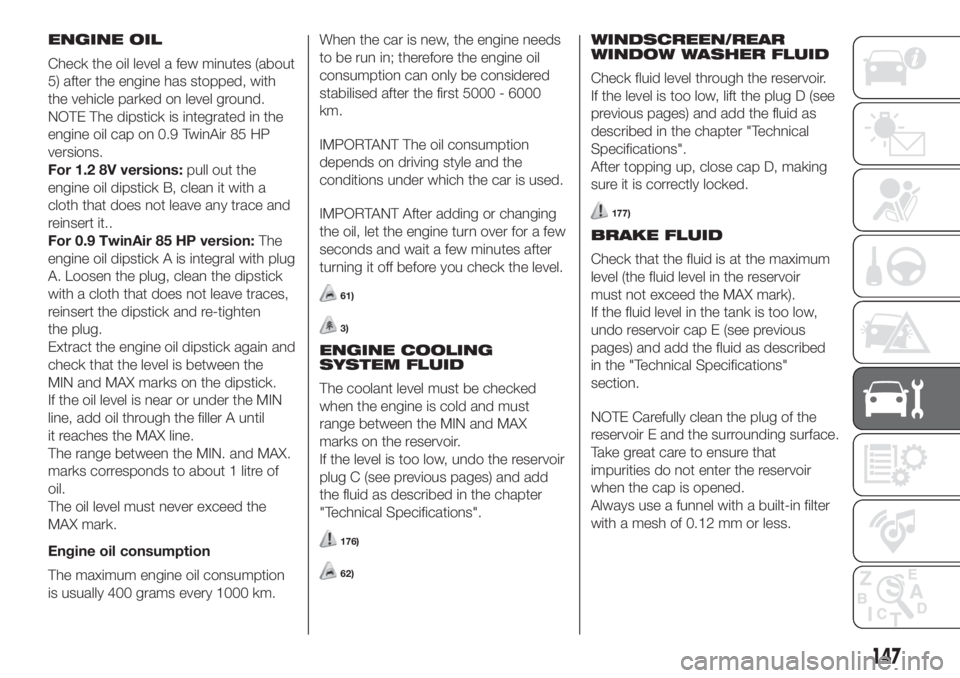
ENGINE OIL
Check the oil level a few minutes (about
5) after the engine has stopped, with
the vehicle parked on level ground.
NOTE The dipstick is integrated in the
engine oil cap on 0.9 TwinAir 85 HP
versions.
For 1.2 8V versions:pull out the
engine oil dipstick B, clean it with a
cloth that does not leave any trace and
reinsert it..
For 0.9 TwinAir 85 HP version:The
engine oil dipstick A is integral with plug
A. Loosen the plug, clean the dipstick
with a cloth that does not leave traces,
reinsert the dipstick and re-tighten
the plug.
Extract the engine oil dipstick again and
check that the level is between the
MIN and MAX marks on the dipstick.
If the oil level is near or under the MIN
line, add oil through the filler A until
it reaches the MAX line.
The range between the MIN. and MAX.
marks corresponds to about 1 litre of
oil.
The oil level must never exceed the
MAX mark.
Engine oil consumption
The maximum engine oil consumption
is usually 400 grams every 1000 km.When the car is new, the engine needs
to be run in; therefore the engine oil
consumption can only be considered
stabilised after the first 5000 - 6000
km.
IMPORTANT The oil consumption
depends on driving style and the
conditions under which the car is used.
IMPORTANT After adding or changing
the oil, let the engine turn over for a few
seconds and wait a few minutes after
turning it off before you check the level.
61)
3)
ENGINE COOLING
SYSTEM FLUID
The coolant level must be checked
when the engine is cold and must
range between the MIN and MAX
marks on the reservoir.
If the level is too low, undo the reservoir
plug C (see previous pages) and add
the fluid as described in the chapter
"Technical Specifications".
176)
62)
WINDSCREEN/REAR
WINDOW WASHER FLUID
Check fluid level through the reservoir.
If the level is too low, lift the plug D (see
previous pages) and add the fluid as
described in the chapter "Technical
Specifications".
After topping up, close cap D, making
sure it is correctly locked.
177)
BRAKE FLUID
Check that the fluid is at the maximum
level (the fluid level in the reservoir
must not exceed the MAX mark).
If the fluid level in the tank is too low,
undo reservoir cap E (see previous
pages) and add the fluid as described
in the "Technical Specifications"
section.
NOTE Carefully clean the plug of the
reservoir E and the surrounding surface.
Take great care to ensure that
impurities do not enter the reservoir
when the cap is opened.
Always use a funnel with a built-in filter
with a mesh of 0.12 mm or less.
147
Page 152 of 228
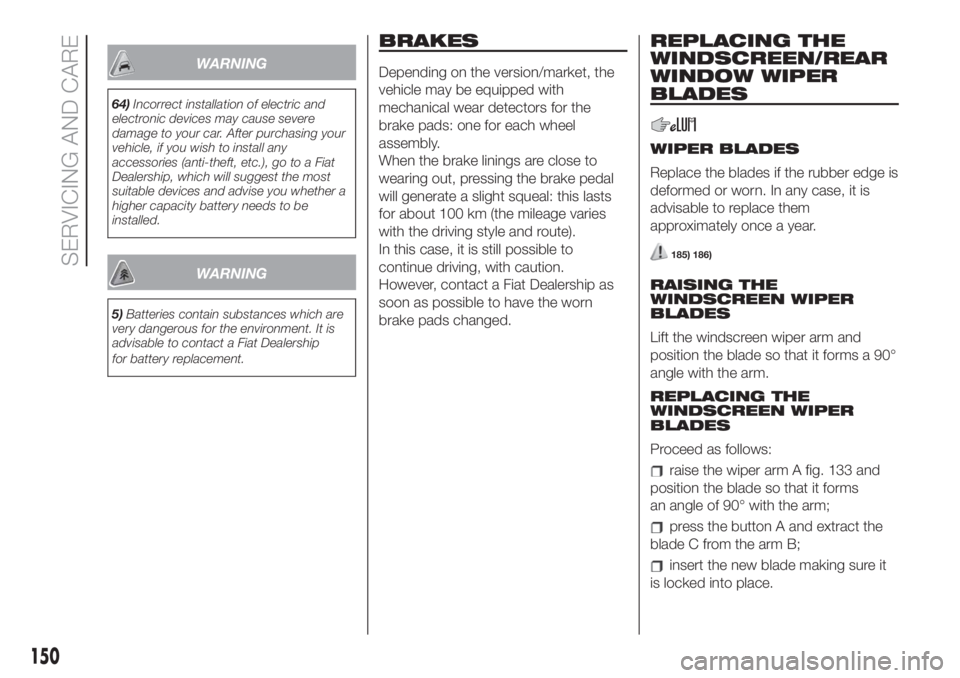
WARNING
64)Incorrect installation of electric and
electronic devices may cause severe
damage to your car. After purchasing your
vehicle, if you wish to install any
accessories (anti-theft, etc.), go to a Fiat
Dealership, which will suggest the most
suitable devices and advise you whether a
higher capacity battery needs to be
installed.
WARNING
5)Batteries contain substances which are
very dangerous for the environment. It is
advisable to contact a Fiat Dealership
for battery replacement.
BRAKES
Depending on the version/market, the
vehicle may be equipped with
mechanical wear detectors for the
brake pads: one for each wheel
assembly.
When the brake linings are close to
wearing out, pressing the brake pedal
will generate a slight squeal: this lasts
for about 100 km (the mileage varies
with the driving style and route).
In this case, it is still possible to
continue driving, with caution.
However, contact a Fiat Dealership as
soon as possible to have the worn
brake pads changed.
REPLACING THE
WINDSCREEN/REAR
WINDOW WIPER
BLADES
WIPER BLADES
Replace the blades if the rubber edge is
deformed or worn. In any case, it is
advisable to replace them
approximately once a year.
185) 186)
RAISING THE
WINDSCREEN WIPER
BLADES
Lift the windscreen wiper arm and
position the blade so that it forms a 90°
angle with the arm.
REPLACING THE
WINDSCREEN WIPER
BLADES
Proceed as follows:
raise the wiper arm A fig. 133 and
position the blade so that it forms
an angle of 90° with the arm;
press the button A and extract the
blade C from the arm B;
insert the new blade making sure it
is locked into place.
150
SERVICING AND CARE
Page 153 of 228
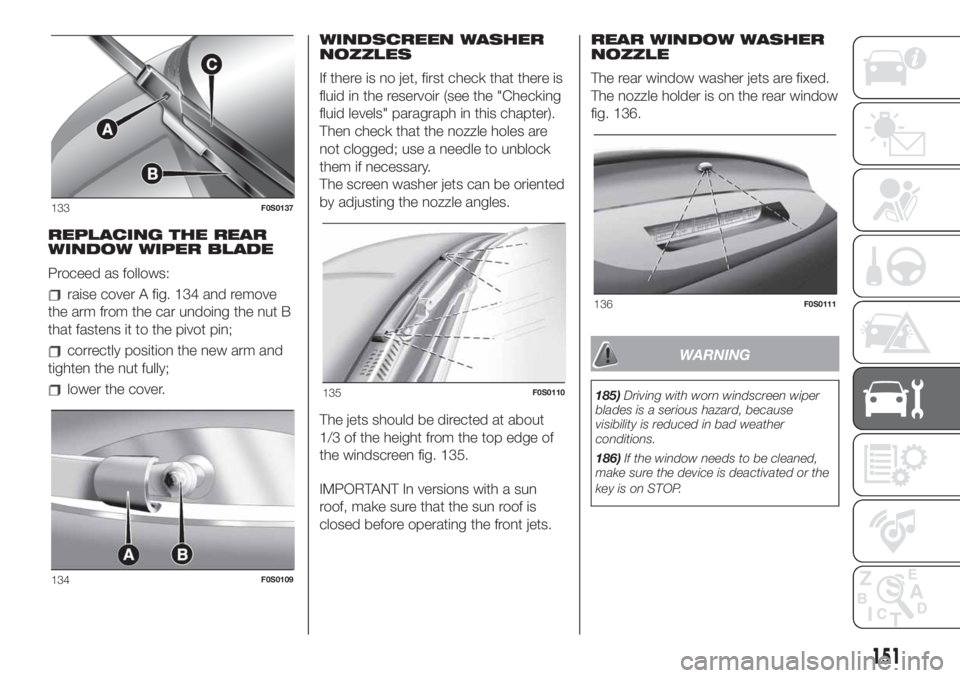
REPLACING THE REAR
WINDOW WIPER BLADE
Proceed as follows:
raise cover A fig. 134 and remove
the arm from the car undoing the nut B
that fastens it to the pivot pin;
correctly position the new arm and
tighten the nut fully;
lower the cover.WINDSCREEN WASHER
NOZZLES
If there is no jet, first check that there is
fluid in the reservoir (see the "Checking
fluid levels" paragraph in this chapter).
Then check that the nozzle holes are
not clogged; use a needle to unblock
them if necessary.
The screen washer jets can be oriented
by adjusting the nozzle angles.
The jets should be directed at about
1/3 of the height from the top edge of
the windscreen fig. 135.
IMPORTANT In versions with a sun
roof, make sure that the sun roof is
closed before operating the front jets.REAR WINDOW WASHER
NOZZLE
The rear window washer jets are fixed.
The nozzle holder is on the rear window
fig. 136.
WARNING
185)Driving with worn windscreen wiper
blades is a serious hazard, because
visibility is reduced in bad weather
conditions.
186)If the window needs to be cleaned,
make sure the device is deactivated or the
key is on STOP.
133F0S0137
134F0S0109
135F0S0110
136F0S0111
151
Page 154 of 228

WHEELS AND TYRES
187) 188) 189) 190)
Check the pressure of each tyre,
including the space-saver spare wheel,
approximately every two weeks and
before long journeys: the pressure
should be checked with the tyre rested
and cold.
It is normal for the pressure to increase
when the car is used; for the correct
tyre inflation pressure, see the “Wheels”
paragraph in the “Technical
specifications” chapter.
WARNING
187)Remember that the road holding
qualities of your car also depend on
correct tyre pressures.
188)If tyre pressure is too low, the tyre
may overheat and be severely damaged as
a result.
189)Do not switch tyres from the
righthand side of the vehicle to the
lefthand side, and vice versa.
190)Never submit alloy rims to repainting
treatments requiring the use of
temperatures exceeding 150°C. The
mechanical properties of the wheels could
be impaired.
BODYWORK
PRESERVING THE
BODYWORK
Paintwork
Paintwork does not only serve an
aesthetic purpose, but also protects the
underlying sheet metal.
Normal care for paintwork consists of
washing the car; how often depends on
the conditions and environment where
the car is used. For example, in highly
polluted areas, or if the roads are
spread with salt, it is advisable to wash
the car more frequently.
IMPORTANT Bird droppings must be
washed off immediately and thoroughly
as the acid they contain is particularly
aggressive.
6)
Versions with matt paintwork
These versions have exclusive matt
paintwork which requires special care
for its preservation. The instructions for
good preservation follow below:
avoid washing with rollers and/or
brushes in washing stations. Then,
wash the vehicle, only by hand, using
pH-neutral detergents; dry it with a wet
chamois leather. Abrasive products
and/or polishes should not be used for
cleaning the car.
Bird droppings must be washed off
immediately and thoroughly as the
acid they contain is particularly
aggressive.
Avoid (if at all possible) parking the
car under trees; remove vegetable
resins immediately as, when dried, it
may only be possible to remove them
with abrasive products and/or polishes,
which is highly inadvisable as they
could alter the typical opaqueness of
the paint.
Do not use pure windscreen washer
fluid for cleaning the windscreen and
the rear window: dilute it to at least
50% with water.
Some versions are fitted with exclusive
decorations on the door mirror covers;
do not use pressurised or high-
temperature jets of water when
washing them.
152
SERVICING AND CARE
Page 155 of 228
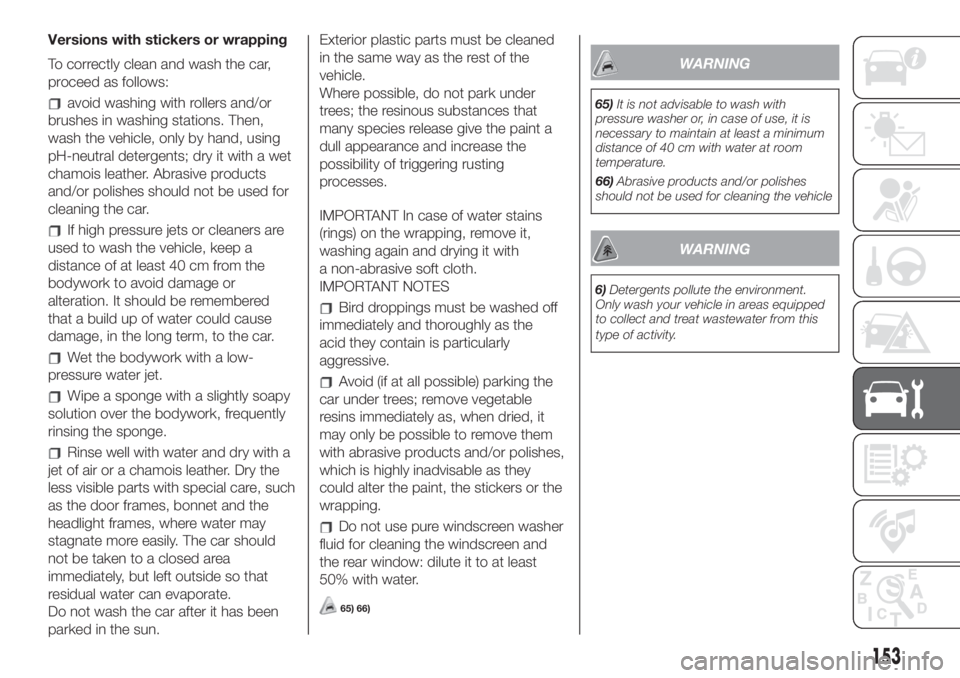
Versions with stickers or wrapping
To correctly clean and wash the car,
proceed as follows:
avoid washing with rollers and/or
brushes in washing stations. Then,
wash the vehicle, only by hand, using
pH-neutral detergents; dry it with a wet
chamois leather. Abrasive products
and/or polishes should not be used for
cleaning the car.
If high pressure jets or cleaners are
used to wash the vehicle, keep a
distance of at least 40 cm from the
bodywork to avoid damage or
alteration. It should be remembered
that a build up of water could cause
damage, in the long term, to the car.
Wet the bodywork with a low-
pressure water jet.
Wipe a sponge with a slightly soapy
solution over the bodywork, frequently
rinsing the sponge.
Rinse well with water and dry with a
jet of air or a chamois leather. Dry the
less visible parts with special care, such
as the door frames, bonnet and the
headlight frames, where water may
stagnate more easily. The car should
not be taken to a closed area
immediately, but left outside so that
residual water can evaporate.
Do not wash the car after it has been
parked in the sun.Exterior plastic parts must be cleaned
in the same way as the rest of the
vehicle.
Where possible, do not park under
trees; the resinous substances that
many species release give the paint a
dull appearance and increase the
possibility of triggering rusting
processes.
IMPORTANT In case of water stains
(rings) on the wrapping, remove it,
washing again and drying it with
a non-abrasive soft cloth.
IMPORTANT NOTES
Bird droppings must be washed off
immediately and thoroughly as the
acid they contain is particularly
aggressive.
Avoid (if at all possible) parking the
car under trees; remove vegetable
resins immediately as, when dried, it
may only be possible to remove them
with abrasive products and/or polishes,
which is highly inadvisable as they
could alter the paint, the stickers or the
wrapping.
Do not use pure windscreen washer
fluid for cleaning the windscreen and
the rear window: dilute it to at least
50% with water.
65) 66)
WARNING
65)It is not advisable to wash with
pressure washer or, in case of use, it is
necessary to maintain at least a minimum
distance of 40 cm with water at room
temperature.
66)Abrasive products and/or polishes
should not be used for cleaning the vehicle
WARNING
6)Detergents pollute the environment.
Only wash your vehicle in areas equipped
to collect and treat wastewater from this
type of activity.
153
Page 168 of 228
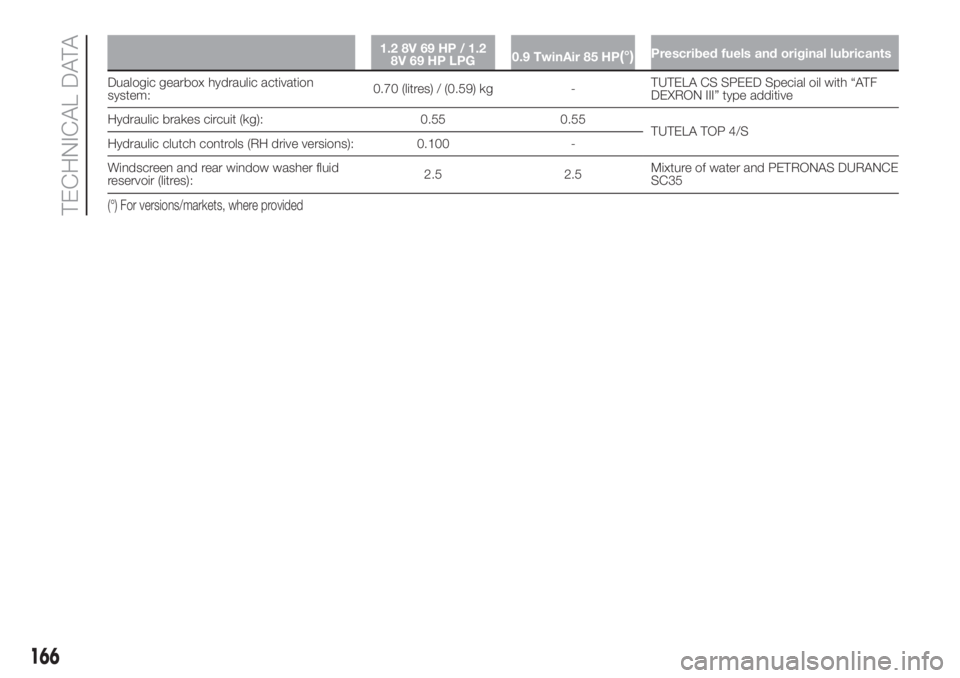
1.2 8V 69 HP / 1.2
8V 69 HP LPG0.9 TwinAir 85 HP(°)Prescribed fuels and original lubricants
Dualogic gearbox hydraulic activation
system:0.70 (litres) / (0.59) kg -TUTELA CS SPEED Special oil with “ATF
DEXRON III” type additive
Hydraulic brakes circuit (kg): 0.55 0.55
TUTELA TOP 4/S
Hydraulic clutch controls (RH drive versions): 0.100 -
Windscreen and rear window washer fluid
reservoir (litres):2.5 2.5Mixture of water and PETRONAS DURANCE
SC35
(°) For versions/markets, where provided
166
TECHNICAL DATA
Page 171 of 228
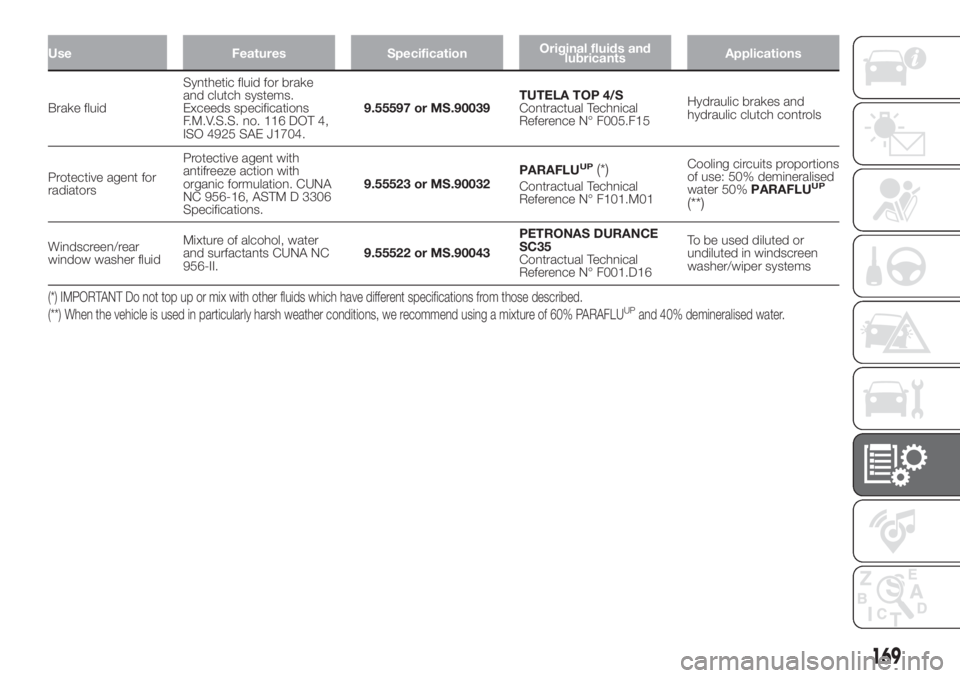
Use Features SpecificationOriginal fluids and
lubricantsApplications
Brake fluidSynthetic fluid for brake
and clutch systems.
Exceeds specifications
F.M.V.S.S. no. 116 DOT 4,
ISO 4925 SAE J1704.9.55597 or MS.90039TUTELA TOP 4/S
Contractual Technical
Reference N° F005.F15Hydraulic brakes and
hydraulic clutch controls
Protective agent for
radiatorsProtective agent with
antifreeze action with
organic formulation. CUNA
NC 956-16, ASTM D 3306
Specifications.9.55523 or MS.90032PARAFLU
UP(*)Contractual Technical
Reference N° F101.M01Cooling circuits proportions
of use: 50% demineralised
water 50%PARAFLUUP
(**)
Windscreen/rear
window washer fluidMixture of alcohol, water
and surfactants CUNA NC
956-II.9.55522 or MS.90043PETRONAS DURANCE
SC35
Contractual Technical
Reference N° F001.D16To be used diluted or
undiluted in windscreen
washer/wiper systems
(*) IMPORTANT Do not top up or mix with other fluids which have different specifications from those described.
(**) When the vehicle is used in particularly harsh weather conditions, we recommend using a mixture of 60% PARAFLUUPand 40% demineralised water.
169
Page 223 of 228
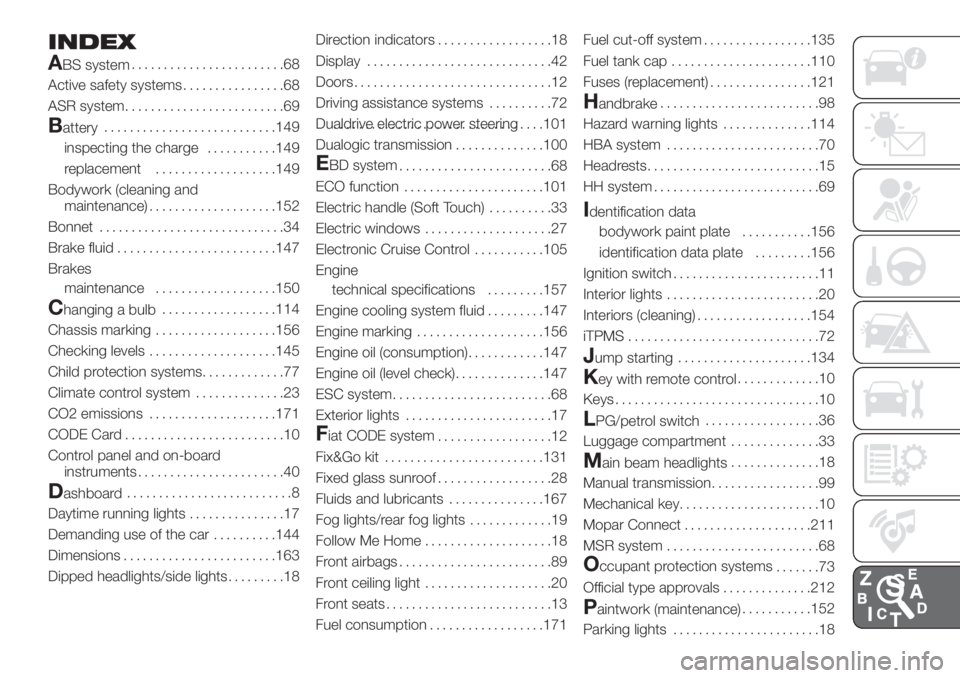
INDEX
A
BS system........................68
Active safety systems................68
ASR system.........................69
Battery...........................149
inspecting the charge...........149
replacement...................149
Bodywork (cleaning and
maintenance)....................152
Bonnet.............................34
Brake fluid.........................147
Brakes
maintenance...................150
Changing a bulb..................114
Chassis marking...................156
Checking levels....................145
Child protection systems.............77
Climate control system..............23
CO2 emissions....................171
CODE Card.........................10
Control panel and on-board
instruments.......................40
Dashboard..........................8
Daytime running lights...............17
Demanding use of the car..........144
Dimensions........................163
Dipped headlights/side lights.........18Direction indicators..................18
Display.............................42
Doors...............................12
Driving assistance systems..........72
Dualdrive electric power steering.................................101
Dualogic transmission..............100
EBD system
........................68
ECO function......................101
Electric handle (Soft Touch)..........33
Electric windows....................27
Electronic Cruise Control...........105
Engine
technical specifications.........157
Engine cooling system fluid.........147
Engine marking....................156
Engine oil (consumption)............147
Engine oil (level check)..............147
ESC system.........................68
Exterior lights.......................17
Fiat CODE system
..................12
Fix&Go kit.........................131
Fixed glass sunroof..................28
Fluids and lubricants...............167
Fog lights/rear fog lights.............19
Follow Me Home....................18
Front airbags........................89
Front ceiling light....................20
Front seats..........................13
Fuel consumption..................171Fuel cut-off system.................135
Fuel tank cap......................110
Fuses (replacement)................121
Handbrake.........................98
Hazard warning lights..............114
HBA system........................70
Headrests...........................15
HH system..........................69
Identification data
bodywork paint plate...........156
identification data plate.........156
Ignition switch.......................11
Interior lights........................20
Interiors (cleaning)..................154
iTPMS..............................72
Jump starting.....................134
Key with remote control.............10
Keys................................10
LPG/petrol switch..................36
Luggage compartment..............33
Main beam headlights..............18
Manual transmission.................99
Mechanical key......................10
Mopar Connect....................211
MSR system........................68
Occupant protection systems
.......73
Official type approvals..............212
Paintwork (maintenance)...........152
Parking lights.......................18
Page 224 of 228
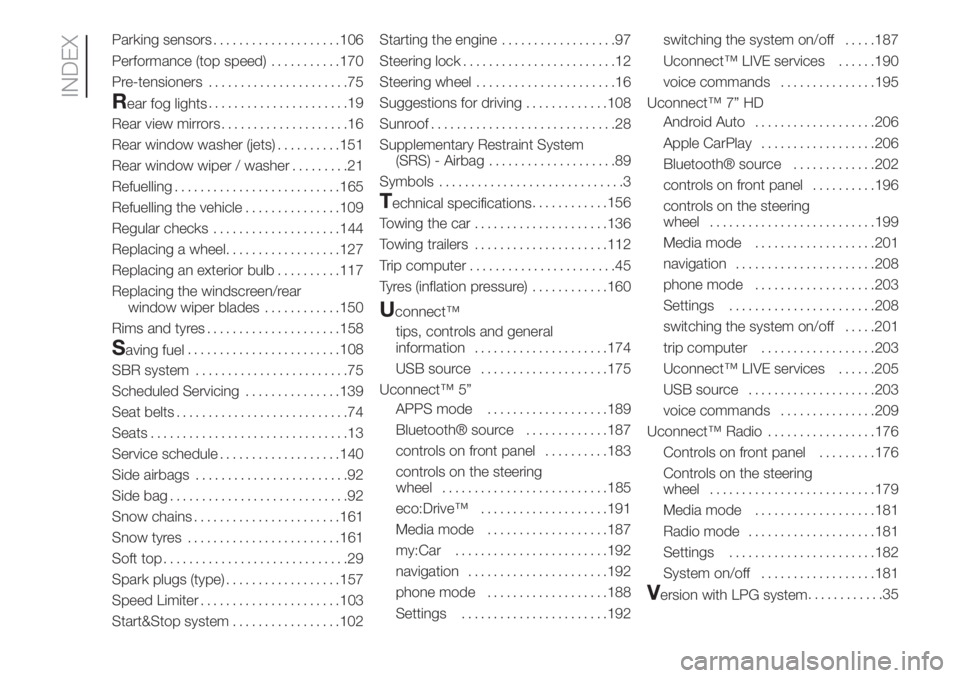
Parking sensors....................106
Performance (top speed)...........170
Pre-tensioners......................75
Rear fog lights......................19
Rear view mirrors....................16
Rear window washer (jets)..........151
Rear window wiper / washer.........21
Refuelling..........................165
Refuelling the vehicle...............109
Regular checks....................144
Replacing a wheel..................127
Replacing an exterior bulb..........117
Replacing the windscreen/rear
window wiper blades............150
Rims and tyres.....................158
Saving fuel........................108
SBR system........................75
Scheduled Servicing...............139
Seat belts...........................74
Seats...............................13
Service schedule...................140
Side airbags........................92
Side bag............................92
Snow chains.......................161
Snow tyres........................161
Soft top.............................29
Spark plugs (type)..................157
Speed Limiter......................103
Start&Stop system.................102Starting the engine..................97
Steering lock........................12
Steering wheel......................16
Suggestions for driving.............108
Sunroof.............................28
Supplementary Restraint System
(SRS) - Airbag....................89
Symbols.............................3
Technical specifications............156
Towing the car.....................136
Towing trailers.....................112
Trip computer.......................45
Tyres (inflation pressure)............160
Uconnect™
tips, controls and general
information.....................174
USB source....................175
Uconnect™ 5”
APPS mode...................189
Bluetooth® source.............187
controls on front panel..........183
controls on the steering
wheel..........................185
eco:Drive™....................191
Media mode...................187
my:Car........................192
navigation......................192
phone mode...................188
Settings.......................192switching the system on/off.....187
Uconnect™ LIVE services......190
voice commands...............195
Uconnect™ 7” HD
Android Auto...................206
Apple CarPlay..................206
Bluetooth® source.............202
controls on front panel..........196
controls on the steering
wheel..........................199
Media mode...................201
navigation......................208
phone mode...................203
Settings.......................208
switching the system on/off.....201
trip computer..................203
Uconnect™ LIVE services......205
USB source....................203
voice commands...............209
Uconnect™ Radio.................176
Controls on front panel.........176
Controls on the steering
wheel
..........................179
Media mode...................181
Radio mode....................181
Settings.......................182
System on/off..................181
Version with LPG system............35
INDEX